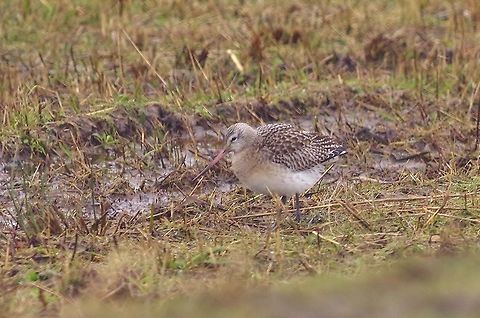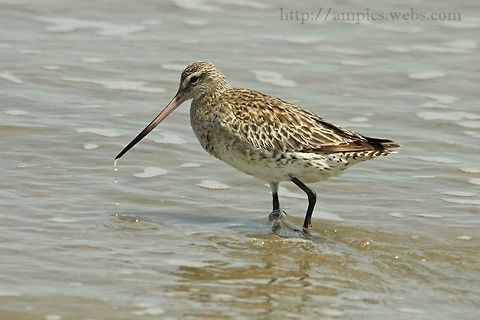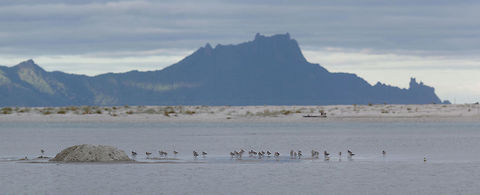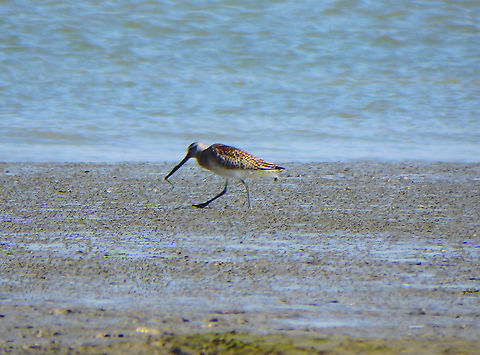
Appearance
The Bar-tailed Godwit is a relatively short-legged species of godwit. The bill-to-tail length is 37–41 cm, with a wingspan of 70–80 cm. Males average smaller than females but with much overlap; males weigh 190–400 g, while females weigh 260–630 g; there is also some regional variation in size. The adult has blue-grey legs and a very long dark bill with a slight upward curve and pink at the tip. The neck, breast and belly are unbroken brick red in breeding plumage, off white in winter. The back is mottled grey.It is distinguished from the Black-tailed Godwit by its barred, rather than wholly black, tail and a lack of white wing bars. The most similar species is the Asiatic Dowitcher.
There are three subspecies, listed from west to east:
⤷ "Limosa lapponica lapponica". Breeds from northern Scandinavia east to the Taymyr Peninsula; winters western coasts of Europe and Africa from the British Isles and the Netherlands south to South Africa, and also around the Persian Gulf. Smallest subspecies, males up to 360 g, females to 450 g.
⤷ "Limosa lapponica menzbieri" Portenko, 1936. Breeds northeastern Asia from the Taymyr Peninsula east to the Kolyma River delta; winters southeastern Asia and Australia. Intermediate between the other two subspecies.
⤷ "Limosa lapponica baueri" Naumann, 1836. Breeds far northeastern Asia east of the Kolyma River, and western Alaska; winters in Australia and New Zealand. Largest subspecies.

Status
The Bar-tailed Godwit is one of the species to which the "Agreement on the Conservation of African-Eurasian Migratory Waterbirds" applies.
Reproduction
The Bar-tailed Godwit is a non-breeding migrant in Australia. Breeding take place each year in Scandinavia, northern Asia, and Alaska. The nest is a shallow cup in moss sometimes lined with vegetation. Both sexes share incubation of the eggs and care for the young.
Food
It forages by probing in mudflats or marshes. It may find insects by sight in short vegetation. It eats mainly insects and crustaceans, but also parts of aquatic plants.
Migration
The Bar-tailed Godwit migrates in flocks to coastal East Asia, Alaska, Australia, Africa, northwestern Europe and New Zealand, where the sub-species "Limosa lapponica baueri" is called Kūaka in Māori....hieroglyph snipped...It was shown in 2007 to undertake the longest non-stop flight of any bird. Birds in New Zealand were tagged and tracked by satellite to the Yellow Sea in China. According to Dr. Clive Minton "The distance between these two locations is 9,575 kilometres, but the actual track flown by the bird was 11,026 kilometres. This was the longest known non-stop flight of any bird. The flight took approximately nine days. At least three other Bar-tailed Godwits also appear to have reached the Yellow Sea after non-stop flights from New Zealand."...hieroglyph snipped...
One specific female of the flock, nicknamed "E7", flew onward from China to Alaska and stayed there for the breeding season. Then on 29 August 2007 she departed on a non-stop flight from the Avinof Peninsula in western Alaska to the Piako River near Thames New Zealand, setting a new known flight record of 11,680 kilometres. Stray birds from Europe and Asia occasionally appear on both North American coasts.
References:
Some text fragments are auto parsed from Wikipedia.